This February and March (and a little bit of April), we’re taking a look at the 1995 to 1996 season of Star Trek, including Star Trek: Deep Space Nine and Star Trek: Voyager. Check back daily for the latest review.
The Thaw is a visually striking piece of Star Trek.
The Thaw is among the most delightfully surreal and abstract episodes of Star Trek to be broadcast after October 1975. One of the more interesting aspects of Star Trek: Voyager is how consciously the show tries to return to the storytelling aesthetic of the original Star Trek show, at least in its early years. While the design aesthetics and characters might have been largely ported over from Star Trek: The Next Generation, the first few seasons of Voyager frequently feel like a conscious attempt to update sixties Star Trek tropes for the nineties.

In darkness dwells…
This is obvious in a number of ways. Caretaker consciously tried to evoke the old “space western” aesthetic, to the point of featuring a Native American first officer and introducing the Kazon as horribly racist “primitive” stereotypes. Time and Again relished primary colour costuming for their suspiciously human-like aliens. These themes became more prominent in the second season, with the b-movie aesthetic of Threshold, the space horror of Persistence of Vision and Meld, and the reverse aging allegory of Innocence.
While Tuvix essentially offers a reverse twist on The Enemy Within, it is The Thaw that feels most obviously like a sixties episode trapped in ember. The allegorical storytelling, the abstract set design, the creepy campy tone. Voyager might be half-way across the galaxy, but it is never too far from the familiar.

“We never bother to scream…
… when your mask came off.”
The Thaw is a rare episode of Star Trek directed by Marvin V. Rush. Rush was a veteran of the franchise, but worked primarily as director of photography. Rush was largely responsible for the visual shift that took place between the second and third seasons of The Next Generation. He worked in that capacity on all four of the “second generation” series, helping to establish the visual tone of each of the four spin-off shows. In spite of that, Rush would only direct a handful of shows for the franchise.
The Thaw and In a Mirror, Darkly, Part II stand out as Rush’s most distinctive directorial work on the franchise. They both stand out for the same reason, having a unique visual style that consciously harks back to the look and feel of the original Star Trek. The connection is obviously more literal on In a Mirror, Darkly, Part II, with the bulk of shooting taking place on sets replicating the classic show. However, The Thaw is rooted in the same visual aesthetic, with a strong and distinctive production design and colour palette.

Colour me excited…
Rush’s work as director of photography shines through The Thaw. It is an episode that is heavily reliant on lighting to establish mood and tone. This is as true outside the dreamworld, with the lighting of the meeting room particular striking in the sequence where Torres relays Fear’s demands to the crew. It is lit in a way that evokes the atmospheric lighting on the Enterprise sets in the original Star Trek, which would feature coloured spotlights in addition to the ambient lighting featured on later shows.
Several of Rush’s directorial choices consciously evoke the mood and tone of the original Star Trek. The use of lighting in the final act, as power slips away from Fear, evokes the lighting design of the prison that held the characters in The Empath. The decision to age Harry through overt cuts – rather than attempting to conceal or disguise the necessary cuts, for example – also feels like a bit of direction from the classic Star Trek show, the way that the scene would have been shot before advances in computer-generated imagery.
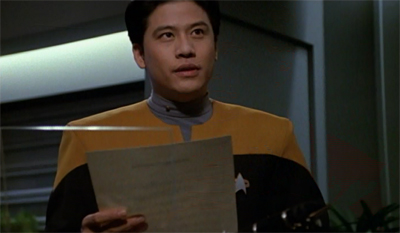
Music to his ears…
Indeed, actor Robert Picardo even acknowledged the connection in a contemporaneous interview with Cinefantastique, making an explicit comparison between The Thaw and the classic Star Trek:
I am injected into their virtual reality, so we see me on a different set. Looks-wise it’s very much like an original series episode. It has vibrant colors, and this sort of very odd cast of guest players that populate this virtual reality sequence that is a major part of the show, with a wonderful guest star, Michael McKean, playing this evil clown.
Indeed, even the basic premise of the episode – a society that has found a creative way to avoid an extinction-level event – recalls the nuclear paranoia underscoring classic Star Trek episodes like A Taste of Armageddon or Wink of an Eye. (It even evokes Khan’s flight in Space Seed.)
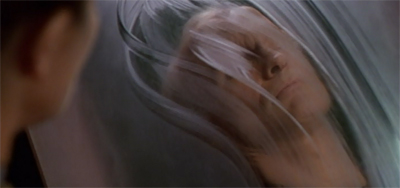
Sleep of reason…
The bulk of The Thaw unfolds in a psychic dreamscape, an imaginary world fashioned from the imaginations of those linked to the machine. There is a delightful incompleteness to that dream world. There is a sense that is free-standing in some sort of void, its walls and steps existing more as set dressing than serving any grand architectural purpose. There is a feeling of unreality to it, heightened by the lighting and colour choices. A lot of The Next Generation and Voyager can feel sterile, but that certainly does not apply to The Thaw.
There are lots of strong primary colours – lots of blues and yellows. There are oversized cartoonish props and bizarre inhabitants. As with Innocence before it and Tuvix after it, the logic of The Thaw is largely metaphorical and abstract in the style of the old science-fiction parables that Star Trek used to spin. The episode focuses on the idea of fear rendered literal, personified and given power. Janeway offers something of a moral in the style of the conversations between Kirk, Spock and McCoy. “Fear only exists for one purpose. To be conquered.”

Clowning around…
The Thaw has a very theatrical sensibility, one that places it at odds with a lot of the surrounding spin-offs. While overseeing the franchise, Rick Berman was very fixated upon the idea that Star Trek should be respectable and serious. This is why the Outstanding Drama Series nomination that The Next Generation received in its final season was so important to Berman, because it demonstrated that the show was being “taken seriously.” It also explains Berman’s battles to rein in the franchise’s scoring, to make the soundscape more understated.
The obvious counterpoint here was the more aesthetic of the original Star Trek series: delightfully over-the-top music; reflective tin foil costumes; actors in full body paint; sets that looked like they were made of cardboard. These aspects made it very easy to spoof Star Trek, to turn it into a joke by pointing out how “fake” it looked. One of the defining attributes of Berman’s time as executive producer was a rejection of that. There was an insistence on the highest possible quality. (And a long-standing resistance to sillier elements like the Andorians.)

“Doctor, can you help me please?”
Mervyn Nicholson argues that the original Star Trek was anchored in a minimalist aesthetic that runs counter to the style of the later spin-offs:
Star Trek has a deeply interesting visual style, but it must be understood in the context of Minimalism. Sets typically look like sets. Scenes on the starship have more realism, corresponding better to what one imagines the interior of a starship would actually be like. But the planet scenes often look blatantly studio-bound. It is almost as if the series were challenging us to accept the fact that it is a studio set we are looking at, in the manner of the “alienation devices” employed by Brecht or other dramatists of the absurdist-Minimalist line of theater, a means of reminding the audience that it is watching a show, not reality. This is very different from the successor series to Star Trek. The successor series are preoccupied with impeccably appointed, detailed settings, showing attention to gadgets in interiors that look like real interiors, and emphasizing interiors more than planetscapes, which are more difficult to mount and less easy to control.
In spite of Berman’s objections, it could be argued that this aesthetic was more memorable than a lot of the look-and-feel employed by the spin-off series.
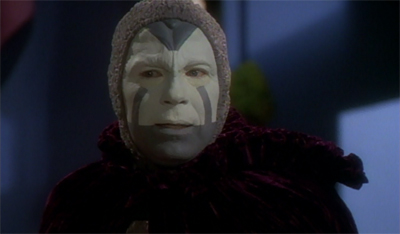
Bonus points for punning on the word “cloak”, so I don’t have to.
Of course, these stylistic touches would occasionally bleed through into the spin-offs. The planets featured in episodes of the first season of The Next Generation – like Hide & Q and The Arsenal of Freedom – looked very much like they were shot on a soundstage rather than attempting to create a convincingly realistic environment. Episodes like Move Along Home had a goofy aesthetic to them that would have fit quite comfortably with Kirk’s adventures. However, by and larger, the franchise moved away from that abstract style of presentation.
As such, the production design on The Thaw is striking. It is heavily stylised and abstract, evoking theatre. One of the characters has a giant head, evoking those seen during the mardi gras celebrations. (Or, perhaps, Frank Sidebottom to British audience members.) The topography of the dream landscape resembles that of a theatre space, with delineated elevations and oversized props that seem designed to ensure characters and events might be clearly visible to a hypothetical audience in the back of the studio space.

Nothing to fear but Fear itself…
Indeed, The Thaw even seems to inherent some more questionable stylistic quirks from the classic Star Trek show. Among Fear’s ensemble is a dwarf ballerina played by Patty Maloney. The ballerina is clearly intended to unsettle and disturb the audience, in a manner that feels quite insensitive for a show airing in the mid-nineties. The creepy dwarf is a pop culture standard, a tradition that likely owes its prevalence to traveling freak shows, but which was incorporated into cinema with Tod Browning’s Freaks, if not earlier.
The creepy dwarf stereotype has endured over the years. In the nineties, David Lynch proved quite fond of the trope; the Man from Another Place in Twin Peaks is an archetypal example of the cliché; although the director made a point to cast actor Michael J. Anderson as a man of regular height in Mulholland Drive. Even the classic Star Trek show was guilt of using the cliché in Plato’s Stepchildren, using the short stature of Alexander to suggest that he was malformed or incomplete compared to his fellow deities.
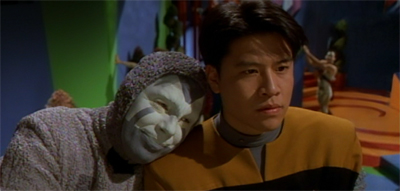
Fear is a constant companion…
It goes without saying that this cliché is insensitive and outdated. More to the point, it is very much lazy writing and casting at this point. Writer and director Tom DiCillo even critiqued it in Living in Oblivion in 1995, having the character of Tito (played by Peter Dinklage) object to his casting in a surrealist dream sequence:
Have you ever had a dream with a dwarf in it? Do you know anyone who’s had a dream with a dwarf in it? No! I don’t even have dreams with dwarfs in them. The only place I’ve seen dwarfs in dreams is in stupid movies like this! ‘Oh make it weird, put a dwarf in it!’ Everyone will go ‘Woah, this must be a f#!?in’ dream, there’s a f#!?in’ dwarf in it!’ Well I’m sick of it! You can take this dream sequence and stick it up your ass!
As such, the casting of Patty Maloney as a ballarina feels more than a little cynical. The character is designed to play off an instinctive response from the audience that views short people as inherently unsettling or creepy. It is very outdated, if unfortunately in keeping with the broader aesthetic of the episode.
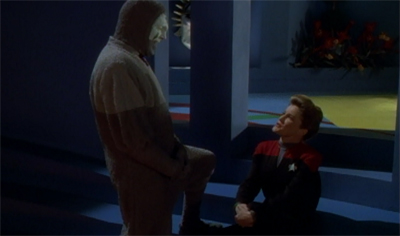
“C’mon, Captain! You’d think we’d be best buddies, given the path you’re about to carve for yourself through the Delta Quadrant!”
Issues with the ballerina aside, The Thaw does capture the tone and mood of the original Star Trek very well. There is a very nightmarish quality to the episode, one that catches the audience off-guard. As overseen by Berman, the Star Trek universe tends to feel tangible and solid; the sets and costumes are designed to make sense within the logical framework of the shared universe. In contrast, the dreamscape in The Thaw feels chaotic and arbitrary. It is fake and unreal, but that unreality makes it all the more uncomfortable.
Appropriately enough for an episode starring the anthropomorphised personification of Fear, The Thaw is a horror story. This is not a surprise; a significant portion of the second season of Voyager is given over to horror stories. Episodes like Persistence of Vision, Cold Fire, Threshold and Meld are very much stories about the horrors and dangers of space. There is a cheap shot to be made about how Tattoo and Alliances are all horrors in their own way, but the point stands. The Thaw is very much of a piece with the horror running through the season.
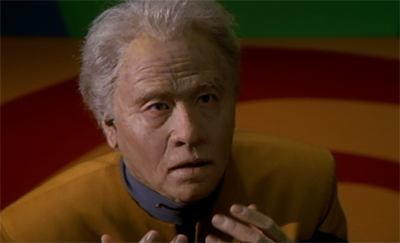
Never getting old!
To be fair, a lot of this is down to the writing staff working on the show. In particular, Brannon Braga is very fond of crafting science-fiction horror stories, whether the psychological horror of something like Frame of Mind and Projections or the goofy b-movie pseudo-scientific terror of something like Genesis or Microcosm. Even after the second season, Voyager will not move away from horror storytelling; episodes like Unity or Darkling continue the tone into the third season and beyond.
However, the horror in The Thaw feels different. It feels abstract and remote. The antagonist in the story is not easily defined or codified. The psychotic clown who holds Harry and B’Elanna hostage cannot be conveniently labelled as Bothan or Ocampan or Nacene. Although he shares the facial ridges with his guests, the monster is not Kohl himself. He is instead cast in their image. There is something innately Other about Fear as he appears in The Thaw, something uncanny and discomforting.

Peace in a sleepin’ pod…
Fear evokes the lonely existential dread that permeated so many of the original Star Trek‘s horror stories. Fear is a reminder that space is often hostile and alien; possibly home to unimaginable horrors lurking in the darkness. Without the rules or labels that govern the Q or the Nestene, Fear evokes the horrors from the original Star Trek that seldom had names. The character is identified in the credits as “The Clown”, evoking the intangible horror of Stephen King’s It. He recalls the giant amoeba of The Immunity Syndrome or Trelane from The Squire of Gothos.
The Thaw was first broadcast on the same night as The Muse. In that Star Trek: Deep Space Nine episode, Jake Sisko encountered a sexy space vampire who essentially fed off his creativity. Both Fear and Onaya feel like conscious attempts to evoke a classic Star Trek aesthetic, suggesting space is home to horrors as well as wonders. However, while Onaya never quite works, Fear comes together perfectly. The character feels like he should be introduced by theremin. (Although, even sans theremin, David Bell provides a great score.)

Well, this guy needs his beauty sleep.
Perhaps Fear works so well because he feels like he is a cultural relic of the sixties. The idea of Fear is universal, echoing across human history. At one point, Harry even quotes Franklin D. Roosevelt in an attempt to ward off the demonic clown. However, the Fear in The Thaw is framed as a response to a very particular existential anxiety. It is tied to fears about the end of the world. As such, those fears resonate with the larger sixties aesthetic of the episode, evoking concerns about mutually-assured destruction or nuclear annihilation.
“All of us had fears about survival, recovery,” Viorsa reflects. “We never anticipated the computer would manifest those fears into him.” As such, Fear embodies that most primal sense of dread; fear of what the future might hold. It is a fear that is universal, but which was particularly strong in the sixties and nineties. In the sixties, it was the spectre of the Cold War that gave the public pause. At the turn of the millennium, fears of biblical reckoning and Y2K caused anxiety. There was also a broader question about what it meant to stand at “the end of history.”

“Harry, I’m not sure that’s nearly ominous enough to score an episode like this.”
To many people, the nineties lacked clear purpose or direction. The Cold War had come to an end; the United States had triumphed over the Soviet Union. However, the World Trade Centre still stood; the War on Terror had yet to be declared. For many of the people who lived through the decade, the nineties represented a lacuna. There were no more enemies to fight, no more worlds to conquer. Francis Fukuyama had infamously suggested that liberal democracy had finally emerged as the dominant political philosophy.
With all of that going on, what could the future possible hold? To the casual observer, the world was relatively stable during the nineties. Between 1991 and 1998, the Doomsday Clock stood further away from midnight than it had at any earlier (or even subsequent) point. There were signs and omens of the threats yet to manifest, but everything was (reasonably) tranquil. However, this tranquility was unsettling. Without an enemy against which the country might be defined, what happened next. Star Trek VI: The Undiscovered Country touched on these fears.
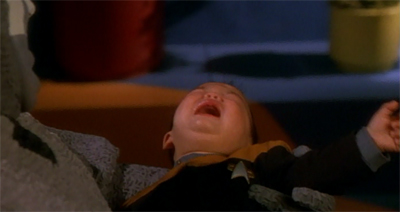
Cry baby…
It also helps that Fear is played by Michael McKean, the veteran performer. McKean fondly recalls his experience working on The Thaw, acknowledging the challenges that it posed:
The aliens who are coming in just for the week, they call them Guest Foreheads, because that’s usually what they go to work on. But I got measured for this strange outfit that I’m wearing in it, this onesie that, if you look very closely at it, it’s kind of crenulated. It’s got deep wrinkles in it, and that’s because it was supposed to be brain matter. I didn’t think anybody was going to get that, but, yeah, sure, okay. It looked cool. And it wasn’t terribly hot. Although they shoot very long days on that; a couple of days it was over 12 hours, so it was a little tedious. They had to keep touching up the makeup, and I’m very ticklish around the lips, so that drove me crazy. But it was a fun thing, and I think I turned out good. It’s kind of a cool one.
McKean is a wonderful guest star, and a casting coup for the show. The second season of Voyager might have its issues, but it features a phenomenal guest cast including Michael McKean, Joel Grey and Brad Dourif.
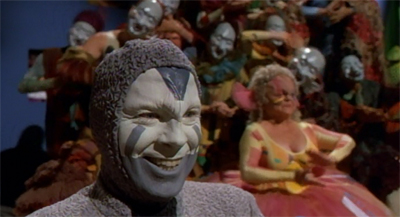
Fear and friends!
Michael McKean was originally a comedian, experiencing his big break when he took the character of Lenny to the show Laverne & Shirley. He has enjoyed a long (and on-going) collaboration with Christopher Guest, with his work as David St. Hubbins in This is Spinal Tap ranking as one of his defining roles. In fact, McKean was a featured player on Saturday Night Live in the season directly before The Thaw aired. While McKean was not exclusively a comedic actor, he was primarily recognisable from his comedy work.
As Fear, McKean pitched his performance as hilarious and terrifying at the same time. (In fact, McKean would even guest-star as the Joker in one episode of Batman: The Animated Series.) There is a rather stylised approach to his work as Fear, befitting the theatrical tone of the episode. At times, McKean adopts a staccato and heightened delivery that recalls William Shatner, most notably during the character’s “bigger” moments. “Heart attack,” he muses at one point. “Now, what might cause a heart attack?”
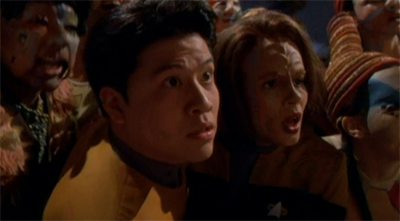
Well, that’s going on the family Christmas card this year…
The Thaw is credited to veteran Star Trek writer Joe Menosky. Menosky is a writer with his own stylistic sensibilities. Menosky is fascinated by abstract concepts and metaphorical storytelling, as his scripts for Darmok and Masks would attest. The Thaw fits quite comfortably within Menosky’s wheelhouse; it is a script that pits the crew against an abstract concept more than a physical opponent. Menosky is a writer who frequently plays with these heightened ideas, and The Thaw counts among his strongest work.
It helps that there is a universality to the theme of the episode. The Thaw couches Fear in a context applicable to both the sixties and the nineties, uncertainty about whether there will be a future and anxiety about what that future might hold. However, Fear runs deeper than that. Fear is a hugely influential motivator, an emotional impulse that has led to all sorts of unconscionable actions. The internment of Japanese-Americans during the Second World War is one such example, although the War on Terror is perhaps the most contemporary frame of reference.
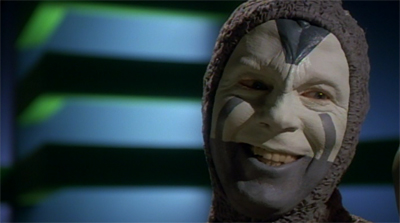
Ladies and gentlemen, lend me your fear!
However, it runs deeper than that. Fear is part of modern political discourse; it arguably has been for quite some time. As Frank Furedi argues in Politics of Fear, such fear is just part of the background noise of modern living:
Advocacy groups often claim that we are not scared enough that the public should be more ‘aware’ of the risks they face. Newspapers compete with one another in the promotion of different scare stories, whether it’s Frankenstein foods, the risks posed by MMR vaccine, economy-flight syndrome, or asylum seekers. The prevalence of such scare stories suggests that society feels uncomfortable with itself. It cannot discuss any problem without going into panic mode. Overnight we discover that obesity is an ‘epidemic’ and is likely to kill more people than smoking does. Discussions about new technology, drugs, health or the environment invariably focus on worst-case scenarios. The cumulative impact is to transform fear into a cultural perspective through which society makes sense of itself. Despite appearances, such fear is not finally limited to specific issues but is about everything. The culture of fear is underpinned by a profound sense of powerlessness, a diminished sense of agency that leads people to turn themselves into passive subjects who can only complain, ‘we are frightened.’
In fact, Deep Space Nine even touched upon this culture of fear earlier in the season, engaging with it as part of Homefront and Paradise Lost, a prescient story about how paranoia justifies the erosion of liberty.
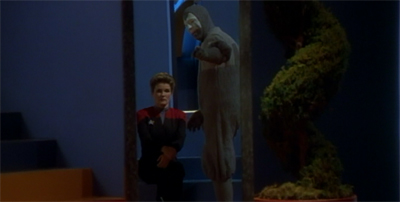
“This could be the start of a beautiful friendship.”
As such, The Thaw feels like a very broad piece of social commentary. It fits quite comfortably with the metaphorical aspects of Innocence, itself a parable about how growing old is like a second childhood. This sort of storytelling is common to the Star Trek franchise, but is most strongly associated with the classic show. “Janeway confronts the personification of fear in a psychic dreamscape” is very much in keeping with “Kirk learns about racism on a planet of people who are literally half-black and half-white.”
In some ways, The Thaw is perhaps too broad. This is most apparent in the sequence in which Fear teases Harry by threatening to put him through an invasive surgery. During that confrontation, Fear tells an overly elaborate story from Harry’s childhood about his trip to the site of “a radiation disaster” and how the sight of “that little girl [he] saw on the operating table” scarred him for life. However, this is the first and only time that this trauma is mentioned. It is never brought up again. Harry never seems uneasy in Sickbay, for example.

You snooze, you lose.
To be fair, this is very much par for the course on episodic television drama. During the first season of The X-Files, the episode Fire revealed that Fox Mulder had a deep-seated fear of fire that was never mentioned again. During the second season of Deep Space Nine, the episode Melora featured Julian Bashir telling a story about why he decided to become a doctor that is very difficult to reconcile with the revelations in Doctor Bashir, I Presume. The needs of the individual episode often trump larger characterisation concerns.
However, The Thaw comes towards the end of the second season. By this point in the run, there should be some sense of who Harry Kim actually is. The story about the “radiation disaster” is not just one jigsaw puzzle piece that doesn’t (and will not) fit. This is the most personal piece of background information that Voyager has chosen to reveal about Harry Kim. It could be argued that this is the most formative and visceral character detail that the show will offer about Harry Kim across its seven-season run. However, it is never mentioned again.
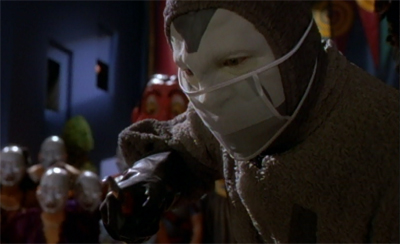
A cutting insight into Harry’s character…
This rigidly episodic approach stands in stark contrast to attempts to weave a continuing story through the second season as a whole, perhaps suggesting a strong reaction to the botched arc running from Alliances through to Investigations. Perhaps the string of late-season stand-alone stories are intended as a blueprint going forward. Given that the Kazon, and Jonas, and Seska could not work, what sense does it make to ever mention Tuvix again or to acknowledge Harry’s supposedly formative trauma?
Still, this is a relatively minor complaint. The Thaw is a standout episode of Voyager, one rather underrated in discussions of the show. It is a demonstration of just how skilfully the show could capture the mood and tone of the original Star Trek, but also a reminder of how rarely that actually happened.
You might be interested in our other reviews from the second season of Star Trek: Voyager:
- The 37’s
- Initiations
- Projections
- Elogium
- Non Sequitur
- Twisted
- Parturition
- Persistence of Vision
- Tattoo
- Cold Fire
- Manoeuvres
- Resistance
- Prototype
- Alliances
- Threshold
- Meld
- Dreadnought
- Death Wish
- Lifesigns
- Investigations
- Deadlock
- Innocence
- The Thaw
- Tuvix
- Resolutions
- Basics, Part I
Episodes produced during the second season, but carried over to the third:
Filed under: Voyager | Tagged: culture of fear, fear, Joe Menosky, marvin v. rush, Michael McKean, star trek: voyager, the thaw, voyager |




















This episode has easily one of the best endings in Star Trek voyager history. Kate Mulgrew’s hiss of the penultimate line still gets to me, and makes me wish Jameway had more moments like this.
Yep. The Thaw is easily one of the better episodes of the season, with Meld.
Yeah, this is one of those episodes you can’t see working on TNG. Which, in Voyager’s case, is good. It’s also very TOS-like, with the mad supercomputer and the killer hippies, which is also up Voyager’s alley. I assume the writers were just playing “Wheel of Trek” and bouncing between the extremes of Kirk and Sisko depending on the scripts they fumbled through.
(If this were ENT, Archer would’ve unplugged the machine and left everyone to their fate, so that’s a wash.)
I love McKean. He’s really the best thing in everything he’s in. This guy can act opposite Johnny Five AND Tom Welling and make it work.
McKean is great. It’s wonderful to see him working so steadily with Vince Gilligan and Peter Gould on Better Call Saul at the moment.
Fear Clown: “I’m afraid”
Janeway: “I knooooow.”
Janeway comes to face to face with the incarnation of fear… and it is fear that is terrified. Thus proving Chuk’s theory that she is the evilest villain in the Star Trek universe.
Unless you’re a member of her own crew.
In which case an attempted mutiny only merits a stern talking-to.
Ah, but she never actually punishes them does she?
“I’m not angry, I’m just disappointed. Now go back to your job and your privileges of rank, and think about what you’ve done.”
Oh wait, I remember an episode where Tom Paris rebelled against her orders and joined a terrorist group on a water planet… and he got sentenced to solitary confinement for thirty days.
All of which led to the hilarious situation where Paris was demoted to Ensign and re-promoted to Lieutenant while Harry watches silently in the background.
Poor dumb Harry…
Sad to say, when I was binge watching Voyager for the first time after the series run was over, I skipped over this gem because the moment I saw the…festival? I thought this was going to be an irritating episode and moved on.
“But I got measured for this strange outfit that I’m wearing in it, this onesie that, if you look very closely at it, it’s kind of crenulated. It’s got deep wrinkles in it, and that’s because it was supposed to be brain matter”
Yeah, I didn’t get that either. As Sfdebris pointed out, he looks like he’s dressed in a carpet provided by Stainmaster. Not the most intimidating outfit, but then again, Heath Ledge Joker didn’t have the most intimidating outfit either (not counting the makeup)
Well, to be fair, The Thaw is a polarising episode, even for those who have watched it. But I love it to death.
The Thaw has been compared to Move Along Home but where that was one of DS9’s major missteps, The Thaw is one of Voyager’s finest hours. Michael McKean gives a sterling performance as the ringmaster of his own little circus of horrors. And I was reminded of It as well. Much like Pennywise, the Kohl computer took their fears and turned them into the Clown that he then uses to prey upon his victims. In fact the ending of The Thaw is far superior to the way the It miniseries ended. Who didn’t feel chills when Fear vanishes into oblivion while the holographic Janeway just looks on?
I thought the little lady was played by Zelda Rubinstein, who I will always remember as Tangina Barrons from the Poltergeist movies (that included a scary clown doll). She no doubt would have played that just as well. There does seem to be a running theme of dwarfism throughout the episode, not just the character played by Patty Moloney, but the way the Janeway hologram is framed to look so small next to the Clown.
Another TOS reference is the scene of Harry aging. It’s easy to compare to The Deadly Years, but it made me think of Uhura recoiled in horror at her aging reflection in And the Children Shall Lead.
Harry was uneasy on the Caretaker’s Array so it might have made more sense for the Clown to draw upon that memory, especially since the examination nearly resulted in Harry’s death. People seem undecided whether or not the Clown says “Drat” or “Dread” at the end. I’m a little unclear on this myself. Was the Parallax Colony in Cost of Living the TNG equivalent of The Thaw? And did you mean Nacene instead of Nestene Darren?
Good spot on that Nestene/Nacene issue.
But yes, a really underrated Voyager episode, all told.
The Nestene are a vaguely Lovecraftian creation (or, if you believe All-Consuming Fire et al. – but not The Taking of Planet 5 – a much more explicitly Lovecraftian creation) either way.
Which is interesting in terms of The Thaw evoking TOS because as has been discussed, there are elements of that Lovecraft “cosmic horror” to early TOS and especially the writings of Robert Bloch for obvious reasons.
Just interesting to me that both Doctor Who and Star Trek should have their own subset of writers who were fascinated with the idea of “canonising” the Great Old Ones in their scripts/novels.
I can’t figure out how the Universal Translator could have been transported into that machine with Kim & Torres. The computer beings and the Kohl peeps shouldn’t have been able to communicate with voyager crew.
If it’s a neural interlink, surely the translator is irrelevant – they’re communicating through thoughts?
Irony of ironies, but the 29th of April (the day The Thaw originally aired) is apparently International Dance Day. Given the episode’s focus on creepy/unsettling dancers, I found it a vaguely amusing yet entirely unintentional resonance.